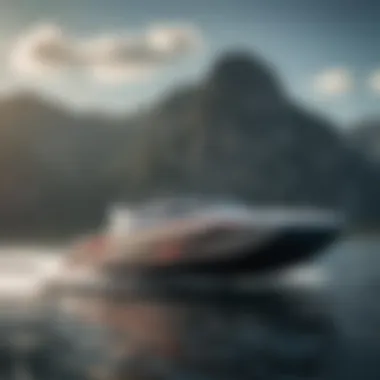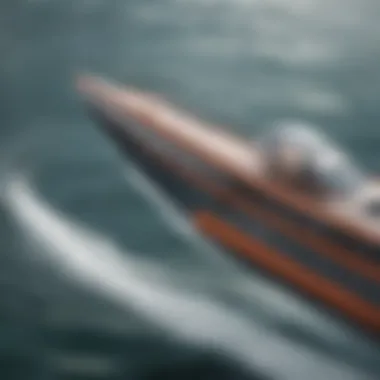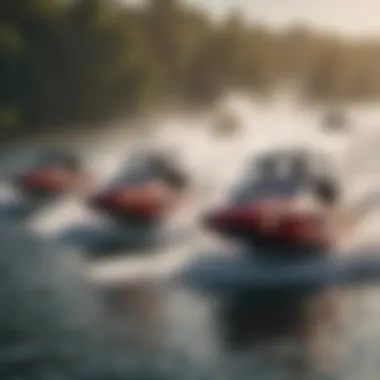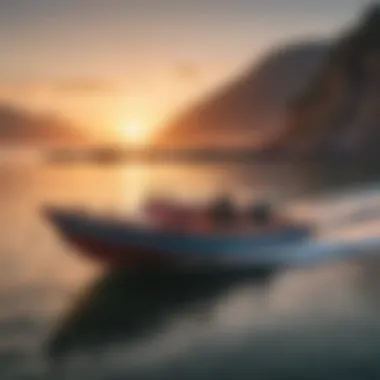The Wing Boat: Exploring a Game-Changer in Watercraft


Intro
As the sun gleams off the water's surface, a new wave of adventure glides into the spotlight: wing boats. This craft, an alchemy of design and engineering, is not just another plaything for watersports enthusiasts; it embodies a paradigm shift in how we engage with our marine environments. The allure of wing boats lies in their unique capacity to harness wind and water dynamics, creating a thrilling experience that appeals to both seasoned sailors and novices alike.
Wing boats, with their sleek structure and advanced mechanisms, cut through the surface like a hot knife through butter. But what exactly makes them stand out in the crowded world of recreational watercraft? This article will take you on a journey through the intricate mechanics and benefits of wing boats, while also touching upon their environmental impacts and future possibilities.
Gear Selection
The choice of gear can make or break your experience on the water. Here, we’ll chat about the key components associated with wing boats—specifically, the types of wings and boards that can elevate your riding experience.
Types of Wings
Not all wings are created equal. When selecting the right wing, keep an eye out for the following types:
- Rigid Wings: These wings boast a solid structure, which allows for greater control even in gusty winds. They are ideal for those looking to master speed and agility.
- Inflatable Wings: Easy to transport and assemble, inflatable wings are great for beginners. They offer a forgiving ride and are less likely to tip over, making them perfect for those just diving into the world of water sports.
- Foil Wings: For thrill-seekers, foil wings provide an exhilarating experience. They enable riders to lift off the water, creating less drag, and allowing for faster navigation.
When choosing your wing, consider not just the type but also the material and size to match your skill level and intended use.
Choosing the Right Board
Your choice of board also plays a pivotal role. Here are some aspects to ponder:
- Size: Larger boards offer more stability, which can be crucial for beginners. Smaller boards, on the other hand, facilitate quicker turns and agility for experienced riders.
- Material: Lightweight materials can enhance maneuverability and make it easier to handle the wing. Carbon fiber is a popular choice for those wanting the best performance.
- Shape: Different shapes can influence how the board interacts with water. A concave shape might provide increased grip, while a flat board can offer more speed.
Selecting the right combination of wing and board can feel like piecing together a jigsaw puzzle, where every choice impacts your overall experience.
"Choosing the right gear transforms not just the ride, but the enjoyment that comes with it."
Skill Development
As with any sport, refining your skills in wing boating is crucial for enjoying every ride. Here, we will highlight key techniques and progression tips that can aid your development.
Essential Techniques
Getting accustomed to wing boating relies on mastering some fundamental skills. Here are essential techniques to focus on:
- Balance: Mastering balance on the board is paramount. Start by finding a comfortable stance and distribute your weight evenly.
- Turning: Practice shifting your weight smoothly. Efficient turning requires understanding your wing’s pull and adjusting your center of mass accordingly.
- Adjusting to Wind: Understanding how to read wind patterns can improve your experience dramatically. Identify when to harness wind power vs. when to steer clear.
Progression Tips
Progressing in skill isn’t just about practice; it involves deliberate measures:
- Set Goals: Define clear, actionable goals. Whether it's mastering jumps or improving your speed, setting these benchmarks can motivate you.
- Video Analysis: Record your rides and review them. Seeing your technique can reveal areas for improvement that you might not feel while riding.
- Seek Feedback: Don’t hesitate to ask for advice from experienced riders, or even consider getting lessons from a certified instructor.
These components can sharpen your skills and enrich your wing boating adventures, creating a more enjoyable experience on the water.
As the world of wing boats continues to evolve, every enthusiast has the opportunity to contribute to its legacy while enjoying an unmatched connection with the aquatic realm. Whether cruising in calm waters or zipping through waves, the right gear and skills are your keys to unlocking a thrilling watercraft experience.
Preface to Wing Boats
The topic of wing boats is not just a fleeting trend in the boating community; it represents a significant shift in how enthusiasts perceive and interact with watercraft. As water sports continue to evolve, wing boats stand out for their unique design and performance capabilities. The idea of utilizing wings, much like in aviation, to enhance speed and agility on water is a brilliant fusion of science and sport.
Understanding wing boats opens up various discussions about their mechanics, advantages, and the potential they hold for both recreational and competitive settings. Additionally, as we move towards more sustainable practices in recreation, the importance of exploring wing boats becomes even more pertinent.
Defining the Wing Boat Concept
At its core, the wing boat concept revolves around integrating wing-like structures into the design of traditional boats. These wings, typically engineered to generate lift, allow the vessel to skim above the water's surface, dramatically reducing drag and increasing speed. When viewing a wing boat, one might initially think of a conventional kayak or sailboat. However, the additional element of wings changes the game, offering an exhilarating experience for pilots.
This innovative approach not only enhances performance but also redefines what enthusiasts expect from their watercraft. No longer confined to the limitations of the hull alone, wing boats present a thrilling alternative for those seeking adventure on the waves. The combination of engineering prowess and adventurous spirit reflects a deep-rooted passion within the water sports community.


Historical Context and Evolution
The genesis of wing boats can be traced back to advances in both aerodynamics and hydrodynamics. In the early instances of sailing and boating, key innovators began to experiment with various designs that prioritized speed and efficiency. The concept began to evolve with the rise of windsurfing and kiteboarding in the 20th century, where the use of sails and boards became increasingly popular.
As technology advanced, the incorporation of wings into vessel designs emerged. For example, consider how the pioneering work done by companies such as R&D Marine has resulted in foldable wing structures for easier transport and deployment. They used insights from aviation to create a watercraft that can harness wind dynamics to not just navigate but soar over water.
The evolution of wing boats has not been a straightforward path. Multiple setbacks and developmental hurdles have tested the resolve of designers and athletes alike. Yet, this iterative process has fostered a deep understanding of water mechanics and the potential for innovation. Today, wing boats are a direct reflection of decades of experimentation, culminating in designs that appeal to both casual users and competitive racers. As such, they stand poised on the brink of major advances in both technology and functionality.
Design Features of Wing Boats
The design features of wing boats are not just a collection of aesthetic choices, but rather a carefully orchestrated blend of technology and innovation aimed at enhancing performance on the water. Understanding these features is crucial for anyone looking to appreciate the capabilities of these unique watercraft. They represent a new chapter in boating technology, providing significant benefits such as improved lift, reduced drag, and optimized stability.
Wing Structure and Functionality
The wing structure in wing boats plays a pivotal role in their mechanics. Unlike traditional boats that rely solely on a hull submerged in water, the wings on these boats interact with airflow to generate lift. When these vessels are in motion, the uniquely designed wings create a pressure difference, effectively lifting the hull out of the water. This greatly reduces contact with the water surface, enabling higher speeds with efforts that are significantly less taxing on the muscles of the rider. Additionally, the wing structure can be adjusted to adapt to various wind conditions or styles of sailing, making it an incredibly versatile element.
A wing boat offers a captivating experience, combining the thrill of sailing with the cutting-edge technology of aerodynamics. It’s almost like flying just above the water, which is a feeling that traditional boating cannot match. Riders often speak of this sensation as akin to a bird gliding on air, a concept that captures the spirit of speed and agility.
Hull Design Innovations
Hull design is another key element that sets wing boats apart from conventional watercraft. The hull is specifically shaped to minimize drag while maximizing stability and control. Features like a sharper bow and a wider rear section help to slice through water more efficiently, while also improving the overall handling of the boat. This design allows for swift maneuvers, particularly in competitive scenarios where split-second decisions can be the difference between victory and defeat.
Moreover, many wing boats incorporate a catamaran-style hull, which further enhances stability. Unlike monohulls that may capsize under pressure, catamarans distribute weight more evenly across a broader surface area. This design consideration makes wing boats not only more stable but also safer for adventurous rides in choppy waters. Competitive kiteboarders and others who love fast watersports often find these attributes appealing, as they allow for daring tricks and maneuvers without as much fear of tipping over.
Materials Used in Construction
When it comes to building these watercraft, the materials used are just as significant as the design. Manufacturers of wing boats often opt for lightweight yet durable materials such as carbon fiber and high-tech composites, which can withstand the rigors of marine environments. These materials not only contribute to the overall weight reduction of the vessel but also enhance its resistance to corrosion and wear.
Additionally, environmental considerations are at play in material choices. Many leading manufacturers are beginning to incorporate sustainable practices by choosing recyclable materials or sourcing them responsibly. This shifts the narrative from merely enjoying water sports to embracing it as a part of a greater eco-conscious effort.
In a nutshell, the design features of wing boats highlight a marriage of art and science that caters specifically to enthusiasts seeking a blend of performance, safety, and eco-friendliness. As innovations continue to emerge, the possibilities for wing boats seem practically limitless. > "Wing boats fuse technology and design to redefine the experience of watercraft, making every outing an adventure."
Mechanics of Wing Boats
The mechanics behind wing boats play a crucial role in understanding how these innovative vessels operate. Unlike traditional boats, wing boats utilize advanced aerodynamic and hydrodynamic principles, which makes them unique in the world of watercraft. This section delves into the fundamental concepts of lift and drag, along with the impressive control systems that enable exceptional maneuverability. For kiteboarders and water sports enthusiasts alike, grasping these mechanics is essential for capitalizing on the performance advantages that wing boats offer.
Principles of Lift and Drag
In the world of aviation and, by extension, watercraft, lift and drag are two opposing forces that dictate performance. When a wing boat is in motion, the wings generate lift by creating a pressure differential. This is akin to how an airplane’s wings function, but with a twist - they operate over water. As the boat glides, the shape and angle of the wings allow air to flow over them, producing lift that elevates the hull out of the water. This effect reduces hull drag significantly, allowing for faster speeds and enhanced efficiency.
Conversely, drag, which is the opposing force to motion, must be minimized for optimal sailing performance. One must think of drag as a kind of brake on the water. The design of wing boats minimizes drag through their sleek hull shapes and well-engineered wing structures. By fine-tuning these features, engineers can strike a balance that maximizes lift while keeping drag at bay. This delicate interplay results in smoother rides and more energy-efficient journeys. Knowing these principles allows kiteboarders to appreciate how wing boats can glide effortlessly across the surface, making the experience not just exhilarating but efficient too.
"Understanding lift and drag is like learning the secrets to the winds; it makes you a better sailor."
Control Systems and Maneuverability
Maneuverability could be considered the hallmark of any competent watercraft, and wing boats take it to new levels. They are outfitted with sophisticated control systems that enable them to respond rapidly to changes in the environment, much like a nimble dancer gliding across the floor. For kiteboarders, this represents an advantage when riding the waves or executing intricate maneuvers in competitive conditions.
The key components in wing boat control systems often include advanced rudders and hydrofoils, which can be adjusted in real-time. These elements allow for precise navigation and quick adjustments in response to wind and water currents. This adaptability is critical not just for enhancing performance but also for ensuring safety in variable conditions.
Moreover, many modern wing boats come equipped with electronic stabilization systems. These utilize sensors and software to automatically balance the vessel, particularly in rough waters where maintaining a steady course can be a challenge. This technology serves the dual purpose of comfort and control, making the experience smoother for both experienced sailors and novices alike.
Maneuverability in wing boats isn’t only about speed and responsiveness; it’s also about an intuitive sailing experience. The ability to pivot and sail at sharp angles, combined with the reduced drag from their unique design, allows them to navigate tight spaces and perform at their best, even when conditions get tricky.
Overall, understanding the mechanics of wing boats—including their principles of lift and drag and the sophisticated control systems at play—equips water sports enthusiasts with the knowledge they need to further explore this fascinating realm of marine activity.
Performance Advantages of Wing Boats
The performance advantages of wing boats encompass a broad array of features that make them distinct in the watercraft community. These advantages speak not just to speed and efficiency but also to safety and stability under various conditions. For practitioners who enjoy high-speed water sports as well as those who prioritize safety, understanding how wing boats excel can enhance both their experience and ability in navigating waters.


Speed and Efficiency Comparison
When comparing wing boats to traditional boats, the speed difference becomes glaringly evident. Wing boats utilize a unique aerodynamic wing design. This configuration permits them to slice through the water with minimal resistance. Their distinctive structure helps the hull rise and glide above the surface rather than plough through, leading to less drag.
A typical example involves a wing boat reaching speeds surpassing 30 knots while using significantly less energy than a conventional powerboat. Many experienced kiteboarders or instructors have noted how this speed can amplify the thrill during recreational excursions. It's not only about moving fast but also how this speed translates into enhanced control during maneuvers.
Moreover, efficiency is not just about faster travel. It relates to fuel consumption too. A well-designed wing boat uses less fuel when compared to conventional craft, making trips not only faster but also less expensive and better for the environment. This perspective aligns with the increasing focus on sustainability among water sports enthusiasts.
Stability and Safety in Various Conditions
Stability is a critical concern for any watercraft operator. The wing boat design lends itself well to stability even in choppy waters. The unique distribution of weight, combined with the shape of the hull and wings, allows wing boats to maintain their course under conditions that might otherwise destabilize other vessels.
For instance, during strong winds or waves, a well-made wing boat can maintain an upright position while others struggle. This attribute is especially important for kiteboarders who often find themselves in unpredictable weather. Practitioners appreciate the peace of mind that comes from knowing that their craft can withstand such forces.
Safety is enhanced through several other features as well. Wing boats are often designed with lower centers of gravity, which helps to reduce the likelihood of capsizing. Additionally, their buoyancy and reserve stability offer a crucial layer of protection. Operators understand that being able to rely on their watercraft's safety features can make all the difference in emergency situations.
"The best boats are not just fast; they're also safe and stable, providing confidence to those who dare to push the limits."
In summary, the performance advantages of wing boats fundamentally redefine the experience of water sports enthusiasts. By providing superior speed and efficiency coupled with enhanced stability and safety, these watercraft stand out as a superior choice for professionals and aficionados alike.
Applications of Wing Boats
The emergence of wing boats marks a transformative shift in various water activities. Their unique design and enhanced performance capabilities have carved out specific niches in recreational, competitive, and commercial sectors. The applications of these advanced watercraft not only enrich user experience but also contribute significantly to marine innovation.
Recreational Use and Sport
Recreational sailing has taken on a whole new dimension with the introduction of wing boats. These vessels are not just vessels; they represent a lifestyle choice for enthusiasts who seek the thrill of the waters. Imagine gliding effortlessly above the surface, harnessing both wind and wave in one harmonious motion.
The performance characteristics of wing boats allow for exhilarating speed and lightness that traditional boats simply cannot match. They’ve revitalized activities like kiteboarding and sailing, providing athletes with enhanced control and responsiveness. This can lead to improved techniques and more daring maneuvers. With these boats, practitioners often report feelings of freedom and excitement that were previously unattainable with standard models.
- Easy to handle for recreational users, creating accessibility for beginners while still challenging experts
- Customization options available, allowing enthusiasts to tailor their experience with varying wing designs and fittings
- Community involvement through organized events and competitions encourages social interaction among water sports lovers
This surge in popularity also leads to an increase in local economies, with more rentals and services springing up to meet demand.
Commercial and Competitive Contexts
The commercial application of wing boats has also shown promising growth. Businesses are exploring their use in various sectors, from tourism to environmental research. These boats can be employed in eco-friendly tours, providing an opportunity for visitors to explore picturesque waterways while minimizing their carbon footprint.
In competitive contexts, wing boats shine brightly. They’ve made waves in racing, where speed and agility are paramount. For instance, professional competitions have begun to integrate wing boats, allowing elite racers to push the boundaries of what's possible on the water. The integration of advanced technology in these races captures the imagination, elevating the profile of water sports overall.
Some points to consider in commercial settings:
- Tourism: Offering wing boat excursions enhances the appeal of destinations, catering to thrill-seekers and nature-lovers alike
- Research applications: Utilized in marine studies, equipped with sensors that collect valuable data while gliding effortlessly
- Competitive edge: Sailors equipped with wing boats can often outperform traditional vessels, changing the face of the sport
Overall, the applications of wing boats are somewhat revolutionary. They serve not only to enhance leisure activities but also hold untapped potential for commercial endeavors and environmental efforts.
"The innovation in watercraft design, as seen with wing boats, shows a promising trajectory for future marine activities, balancing performance with environmental consciousness."
As we sift through this intricate tapestry of wing boat applications, it becomes evident that they are paving the way for future developments in recreation and commercial sectors alike.
Environmental Considerations
The integration of wing boats into aquatic activities raises significant discussions surrounding environmental implications. As we speed through the wonders of this innovative watercraft, understanding its impact on marine ecosystems and sustainability choices is crucial. The unique design of wing boats not only challenges traditional watercraft but also encourages further scrutiny of how such innovations can coexist with environmental stewardship.
Impact on Marine Ecosystems
When it comes to marine ecosystems, the introduction of any new watercraft can provoke a variety of responses from the environment. Wing boats, with their specialized designs, might interact differently with oceanic life than conventional boats.
For instance, the efficiency of wing boats in slicing through waves can potentially reduce noise pollution, which is often detrimental to marine life. Studies have shown that excessive noise can disrupt the behaviors of marine animals, from fish mating rituals to the navigation abilities of whales. Therefore, a quieter, more streamlined vessel like the wing boat could foster healthier ecosystems, promoting the longevity of these habitats.


However, vigilance is necessary. It is essential to ensure that the materials used and the boating practices encourage a harmonious relationship with the marine surroundings. To minimize disturbances:
- Favor navigational routes that avoid sensitive aquatic areas
- Maintain low speeds in regions essential for wildlife spawning
- Engage in cleanup activities after usage sessions, ensuring human impact does not lead to littered waters
"The way we handle our recreational activities on water reflects our commitment to preserving marine ecosystems for generations to come."
Sustainability in Material Choices
In the realm of environmental considerations, the choice of materials used in constructing wing boats is paramount. This revolutionary watercraft must balance performance and ecological impact, leading manufacturers to explore sustainable alternatives carefully.
Material selection not only influences the boat's weight and performance but also its environmental footprint. Some materials being considered include:
- Recycled composites: These can provide durability without the environmental toll that new materials often impose. Utilizing recycled materials helps in reducing the demand for virgin resources, ultimately lessening the ecological footprint of production.
- Biodegradable materials: While still in the research phase, these materials aim to decrease waste within ecosystems post-use. Particularly in cases of accidental loss or environmental accidents, biodegradable options could alleviate long-term pollution concerns.
- Lightweight materials: Using lighter materials helps in reducing fuel consumption, which is beneficial not just for efficiency but also for decreasing greenhouse emissions.
As the industry progresses, it’s vital for innovators and enthusiasts alike to keep sustainability at the forefront of discussions regarding wing boats. Integrating environmental considerations into every stage—from design to construction, can carve a niche for these vessels that honors our oceans, rivers, and lakes.
Future of Wing Boats
The future of wing boats paints a bright picture, full of possibilities and innovative advancements. As technology evolves, the very fabric of watercraft design is undergoing transformative changes. This section explores essential elements that shape the upcoming journey of wing boats, including potential technological innovations and prospects for industry growth. The discussion emphasizes how these elements intertwine with the growing interest in water sports, especially among kiteboarders, instructors, and event organizers.
Technological Innovations on the Horizon
The advances in materials science and engineering are set to redefine wing boats. The integration of lightweight, high-strength composites opens new doors. For instance, materials like carbon fiber and advanced polymers may become the norm. These innovations not only reduce weight but can increase durability and performance. Imagine a wing boat that can withstand extreme weather conditions while maintaining superior handling.
Additionally, the use of smart technology can further enhance the user experience. From navigation systems with real-time weather updates to automated control systems that adapt to environmental changes, the idea of a connected vessel is closer than ever. Such features mean that operators can focus on enjoying the ride rather than constantly adjusting controls. This ease of use appeals particularly to newcomers in the sport, making participation less intimidating.
Some potential innovations indeed include:
- Eco-friendly propulsion: Using electric engines powered by solar panels could dramatically decrease the carbon footprint of wing boats.
- Augmented reality displays: Implementing them could aid in training, showing real-time data about the water's condition.
- Adaptive wing systems: Wings that can change shape based on speed and wind conditions would provide unmatched versatility.
Advanced materials and technologies can profoundly impact the performance of watercraft, steering the future of wing boats into uncharted waters.
Potential for Industry Growth
The burgeoning interest in water sports has created ripe conditions for industry growth in wing boats. The retail market has seen an upswing, thanks to enthusiasts seeking new experiences. As a result, manufacturers are stepping up their game, pushing boundaries and crafting boats that cater to a wider audience.
The global market for water sports is forecasted to expand significantly. Factors driving this increase include:
- Rising tourism: Locations known for water sports are becoming more popular. Destinations are investing in infrastructure for watercraft rental services.
- Increased accessibility: With more affordable options entering the market, individuals from different backgrounds can learn and participate.
- Community engagement: Kiteboarding events and competitions are on the rise, fostering a sense of belonging and excitement. This guerrilla marketing has proven to be effective in gathering enthusiasts.
Future growth will not only focus on expanding existing markets but also penetrating new regions. Specialty shops may emerge in coastal areas, focusing exclusively on wing boats and their components. Training schools might integrate these craft into their programs, broadening the scope of education in watersports.
In summary, the future of wing boats appears promising. With technological developments on the horizon and ample opportunities for growth within the market, one can anticipate a thrilling evolution that will captivate enthusiasts and operators alike.
End
In wrapping up our exploration of wing boats, it's important to reflect on the myriad aspects that shape this innovative class of watercraft. The wing boat represents a leap, an exciting progression in both design and function that caters to a diverse range of users, from leisure sailors to competitive racers. Understanding its intricate engineering and superior performance capabilities reveals not just what sets it apart, but why it matters in today's maritime landscape.
Summarizing Key Insights
Let's take a moment to sum up the key points:
- Revolutionary Design: Wing boats incorporate cutting-edge aerodynamics with a strong emphasis on lift and drag principles. This optimises movement on water, making them incredibly efficient.
- Enhanced Performance: These vessels offer higher speeds compared to traditional boats, resulting from their unique wing structures that harness the power of the wind and water.
- Versatile Applications: Their design allows for various uses, from recreational to competitive settings. This versatility attracts a broad audience, fostering a community of enthusiasts and professionals.
- Environmental Awareness: The materials and technologies used in constructing wing boats often prioritize sustainability, addressing modern concerns about marine ecosystems.
Key Takeaway: With innovation at their core, wing boats are not merely a novelty in watercraft but a potential game-changer in how we approach aquatic activities.
These insights illustrate the growing significance of wing boats in the context of maritime activities. They redefine how performance is perceived, proving that advancing technology can coexist harmoniously with the natural world.
Encouraging Further Exploration
As we conclude, it’s crucial to encourage readers to delve deeper into the world of wing boats. Engage with local clubs or organizations like the Kiteboarding Association. They often host events where you can witness the wing boats in action and even test the waters yourself.
- Read More: Articles on sites like Britannica offer historical perspectives on maritime advancements.
- Join the Community: Reddit has lively discussions on upcoming designs and user experiences. Check out the wing boat community for firsthand accounts.
- Attend Events: Keep an eye on events on Facebook related to water sports. You can often find opportunities for hands-on experiences and demonstrations.
In summary, as the popularity of wing boats continues to grow, engaging with the community, attending events, and following advancements in technology can deepen your understanding and appreciation of this groundbreaking watercraft. The future of wing boats is bright, and your involvement in it can only enhance the shared adventure that awaits on the water.















